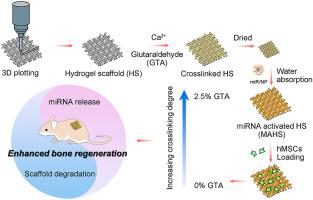Bioactive Materials ( IF 18.9 ) Pub Date : 2021-09-03 , DOI: 10.1016/j.bioactmat.2021.08.034 Ting Pan 1, 2 , Wenjing Song 1, 3, 4 , Hongbao Xin 2 , Haiyue Yu 5 , He Wang 6 , Dandan Ma 6 , Xiaodong Cao 1, 3, 4 , Yingjun Wang 1, 3, 4

|
Bone defects remain a major threat to human health and bone tissue regeneration has become a prominent clinical demand worldwide. The combination of microRNA (miRNA) therapy with 3D printed scaffolds has always posed a challenge. It can mimic physiological bone healing processes, in which a biodegradable scaffold is gradually replaced by neo-tissue, and the sustained release of miRNA plays a vital role in creating an optimal osteogenic microenvironment, thus achieving promising bone repair outcomes. However, the balance between two key factors - scaffold degradation behavior and miRNA release profile - on osteogenesis and bone formation is still poorly understood. Herein, we construct a series of miRNA-activated hydrogel scaffolds (MAHSs) generated by 3D printing with different crosslinking degree to screened the interplay between scaffold degradation and miRNA release in the osteoinduction activity both in vitro and in vivo. Although MAHSs with a lower crosslinking degree (MAHS-0 and MAHS-0.25) released a higher amount of miR-29b in a sustained release profile, they degraded too fast to provide prolonged support for cell and tissue ingrowth. On the contrary, although the slow degradation of MAHSs with a higher crosslinking degree (MAHS-1 and MAHS-2.5) led to insufficient release of miR-29b, their adaptable degradation rate endowed them with more efficient osteoinductive behavior over the long term. MAHS-1 gave the most well-matched degradation rate and miR-29b release characteristics and was identified as the preferred MAHSs for accelerated bone regeneration. This study suggests that the bio-adaptable balance between scaffold degradation behavior and bioactive factors release profile plays a critical role in bone regeneration. These findings will provide a valuable reference about designing miRNAs as well as other bioactive molecules activated scaffold for tissue regeneration.
中文翻译:

3D打印产生的MicroRNA激活的水凝胶支架加速骨再生
骨缺损仍然是人类健康的主要威胁,骨组织再生已成为世界范围内突出的临床需求。microRNA (miRNA) 疗法与 3D 打印支架的结合一直是一个挑战。它可以模拟生理性骨愈合过程,其中可生物降解的支架逐渐被新组织取代,并且 miRNA 的持续释放在创造最佳成骨微环境中起着至关重要的作用,从而实现了有希望的骨修复结果。然而,关于成骨和骨形成的两个关键因素——支架降解行为和 miRNA 释放曲线——之间的平衡仍然知之甚少。在此处,体外和体内. 尽管具有较低交联度的 MAHS(MAHS-0 和 MAHS-0.25)在缓释曲线中释放了更多的 miR-29b,但它们降解太快,无法为细胞和组织向内生长提供长期支持。相反,尽管具有较高交联度的 MAHS(MAHS-1 和 MAHS-2.5)的缓慢降解导致 miR-29b 的释放不足,但它们适应性的降解速率使其具有更有效的长期骨诱导行为。MAHS-1 具有最匹配的降解率和 miR-29b 释放特性,并被确定为加速骨再生的首选 MAHS。这项研究表明,支架降解行为和生物活性因子释放曲线之间的生物适应性平衡在骨再生中起着关键作用。



























 京公网安备 11010802027423号
京公网安备 11010802027423号